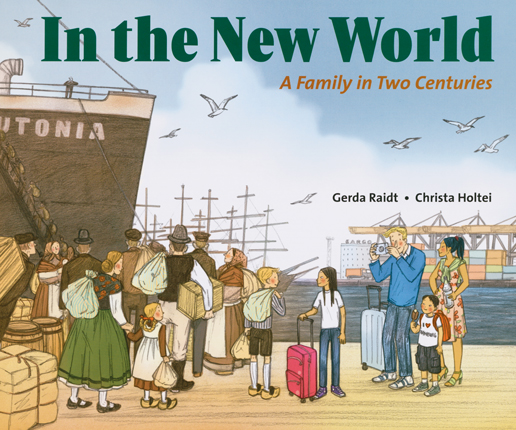Full Text Reviews: Booklist - 03/01/2015 *Starred Review* In 1869, Robert and Margarete Peters emigrate from Germany to America with their two children. Taking few possessions, they travel by train, steamship, riverboat, and wagon to reach their homestead on the Nebraska prairie. They build a sod house first, but later they replace it with a sturdy farmhouse that remains in the family for generations. Almost 150 years later, a school project leads their descendants to look into their history. Intrigued by their ancestors who started the farm, the two children and their parents travel to their ancestral home. First published in Germany, this picture book offers a highly accessible, long-range perspective on the immigrant experience. The translated text reads smoothly and includes enough specific information about the nineteenth-century Peters’ lives to make their story gripping, while the shorter section on the modern Peters may lead readers to wonder about branches on their own family trees. At least half of each broad, double-page spread is given over to Raidt’s lively illustrations—detailed pencil drawings with subdued color washes. Page layouts are nicely varied, with short sections of text nestled alongside small pictures. On the endpapers, decorative maps show each family’s journey. Attractive and informative, this is a fine addition to the immigration shelves. - Copyright 2015 Booklist. School Library Journal - 04/01/2015 Gr 3–5—This fascinating picture book blend of fiction and nonfiction uses the story of the Peterses, a made-up German immigrant family and their fifth-generation American descendants, to explore immigration in the 19th century. Through well-crafted text and charming, detailed drawings, Holtei and Raidt convey the severe economic conditions that precipitated the Peterses' journey in 1869. Charming panoramas of the Peterses' home and village and close-ups of their careful planning prepare readers for the trip's progression, including what items the family carried with them in the one trunk allowed aboard the Teutonia. Onward from their passage in steerage, the Peterses disembarked in New Orleans and transferred to the steamship Princess on their way to Nebraska. There they made their final connection to their new home via covered wagon. Well-written paragraphs expand on topics such as "Life in Steerage" and "Seeing the New World." The narrative then highlights the fifth-generation of Peterses, who traveled back to their ancestral home in Germany to uncover their history. This tale emphasizes the triumph born of hard work and industry, themes that reflect the experiences of many immigrants to America, and humanizes this period. VERDICT A thoroughly delightful and informative story that may even inspire some readers to discover the joys of genealogy for themselves.—Nancy Call, Santa Cruz Public Libraries, Aptos, CA - Copyright 2015 Publishers Weekly, Library Journal and/or School Library Journal used with permission. Bulletin for the Center... - 06/01/2015 In this fact-based German import, Raidt and Holtei follow the migration of Robert and Margarete Peters and their two children from Germany to Nebraska in 1869. The family is no longer able to raise a sufficient flax crop in their homeland to support the Peters’ linen weaving business. Lured by plentiful land in the United States, Robert and his wife decide to auction their property, bid farewell to their extended family, and make their way to Hamburg, across the Atlantic in steerage, up the Mississippi on a stern wheeler, across the prairie by train, to finally claim land in Nebraska. After five years of homesteading, they own their land outright and their family expands; 150 years later, their descendants make the reverse trip to Germany, hoping to locate the original house vacated by their ancestors. The picture-book format suggests a young audience, but vocabulary and attention to detail will recommend this to middle-graders who are studying immigration in social studies. Unfortunately, the Peters’ experience in Nebraska has been fortuitously condensed to the point of incredibility. Within their first year in America they have built a sod house, planted and harvested a crop, and built and furnished a commodious two-story wooden house, complete with outbuildings and fenced fields, and added another member to the family. Careful examination of the mixed-media illustrations rewards readers with insight into the social dynamics of mass immigration for the migrants, those they leave behind, and those who meet them. Older readers may appreciate the decades of social change that brought the Peterses-now a mixed-race family-back to their roots. EB - Copyright 2015 The Board of Trustees of the University of Illinois. Loading...
|



